Analysis of Genetically Modified Organisms in the Food Industry
VerifiedAdded on 2023/05/29
|12
|2882
|446
Report
AI Summary
This report delves into the applications of Genetically Modified Organisms (GMOs) within the food industry, examining their potential to enhance crop yields, develop disease-resistant varieties, and produce foods with improved nutritional value. The study employs a thematic analysis of secondary literature to explore the future prospects of GMOs, including the development of plant and animal species capable of producing therapeutic enzymes and reducing harmful substances in food products. While highlighting the potential of GMOs to address food crises and improve health, the report also acknowledges concerns about the environmental and human health impacts, such as the potential for antibiotic resistance and disruption of ecosystems. The report concludes by emphasizing the importance of further research to fully understand the long-term implications of GMOs, offering recommendations for future studies, and underscoring the need for a balanced approach that considers both the benefits and risks of this technology.
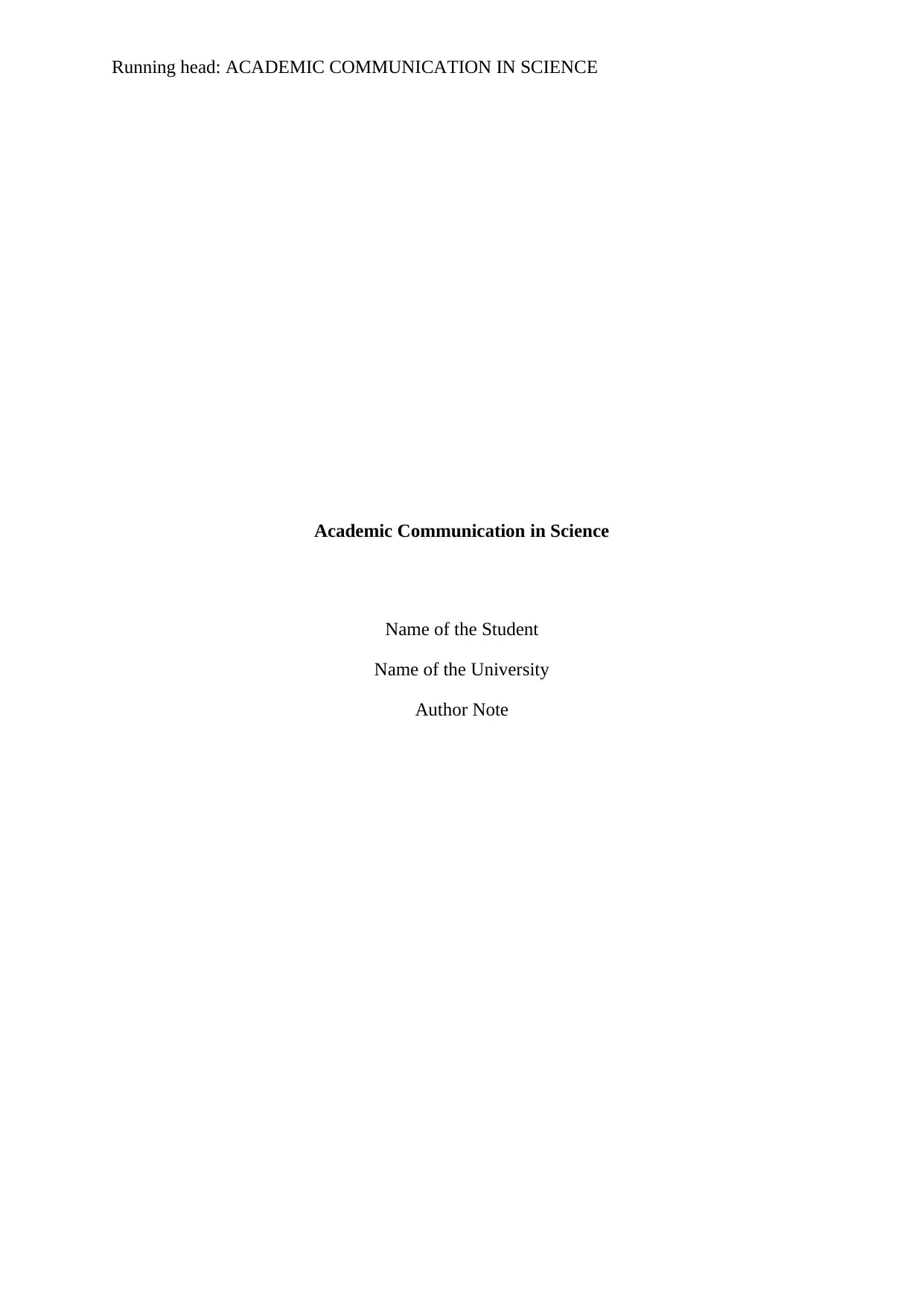
Running head: ACADEMIC COMMUNICATION IN SCIENCE
Academic Communication in Science
Name of the Student
Name of the University
Author Note
Academic Communication in Science
Name of the Student
Name of the University
Author Note
Paraphrase This Document
Need a fresh take? Get an instant paraphrase of this document with our AI Paraphraser
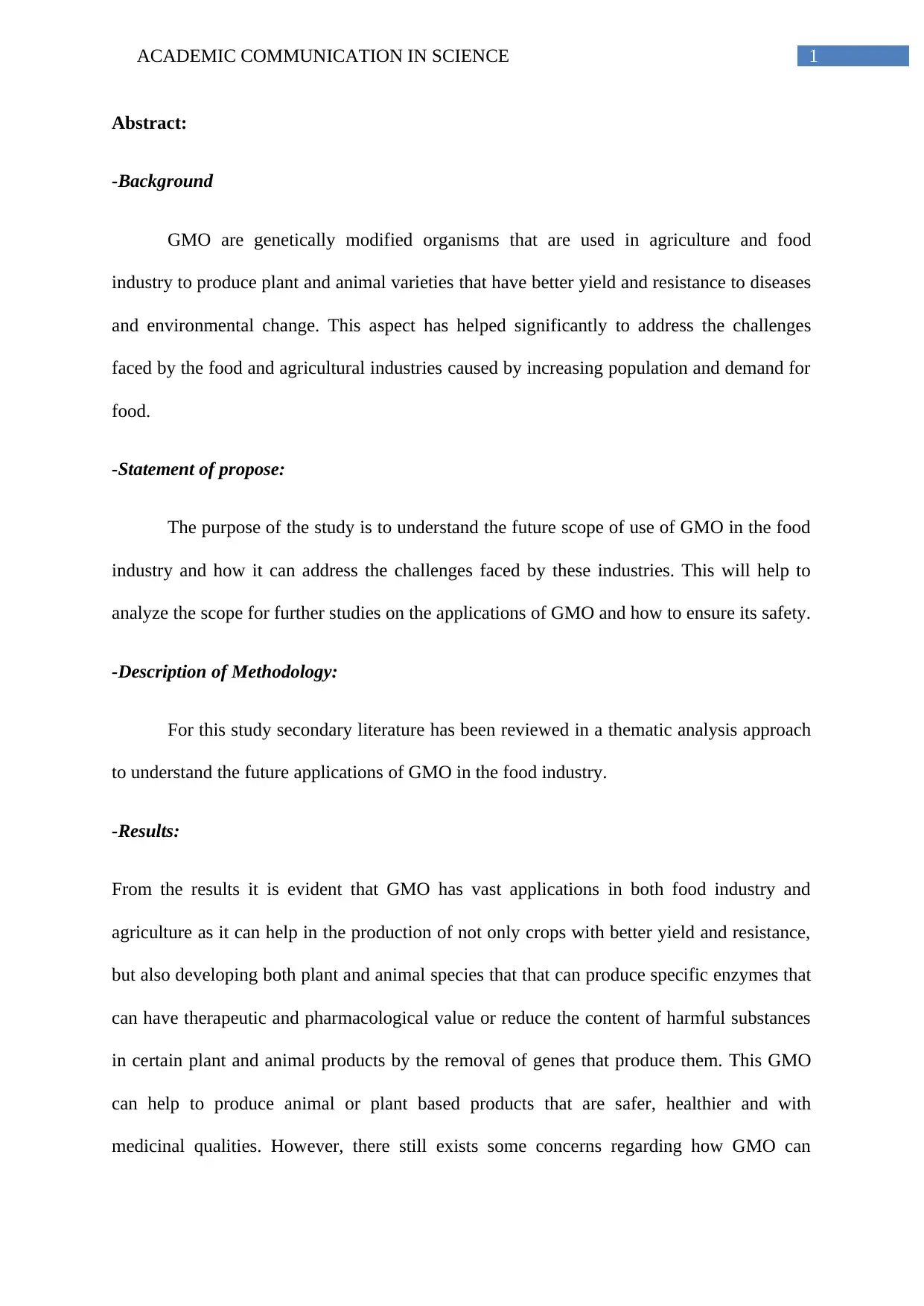
1ACADEMIC COMMUNICATION IN SCIENCE
Abstract:
-Background
GMO are genetically modified organisms that are used in agriculture and food
industry to produce plant and animal varieties that have better yield and resistance to diseases
and environmental change. This aspect has helped significantly to address the challenges
faced by the food and agricultural industries caused by increasing population and demand for
food.
-Statement of propose:
The purpose of the study is to understand the future scope of use of GMO in the food
industry and how it can address the challenges faced by these industries. This will help to
analyze the scope for further studies on the applications of GMO and how to ensure its safety.
-Description of Methodology:
For this study secondary literature has been reviewed in a thematic analysis approach
to understand the future applications of GMO in the food industry.
-Results:
From the results it is evident that GMO has vast applications in both food industry and
agriculture as it can help in the production of not only crops with better yield and resistance,
but also developing both plant and animal species that that can produce specific enzymes that
can have therapeutic and pharmacological value or reduce the content of harmful substances
in certain plant and animal products by the removal of genes that produce them. This GMO
can help to produce animal or plant based products that are safer, healthier and with
medicinal qualities. However, there still exists some concerns regarding how GMO can
Abstract:
-Background
GMO are genetically modified organisms that are used in agriculture and food
industry to produce plant and animal varieties that have better yield and resistance to diseases
and environmental change. This aspect has helped significantly to address the challenges
faced by the food and agricultural industries caused by increasing population and demand for
food.
-Statement of propose:
The purpose of the study is to understand the future scope of use of GMO in the food
industry and how it can address the challenges faced by these industries. This will help to
analyze the scope for further studies on the applications of GMO and how to ensure its safety.
-Description of Methodology:
For this study secondary literature has been reviewed in a thematic analysis approach
to understand the future applications of GMO in the food industry.
-Results:
From the results it is evident that GMO has vast applications in both food industry and
agriculture as it can help in the production of not only crops with better yield and resistance,
but also developing both plant and animal species that that can produce specific enzymes that
can have therapeutic and pharmacological value or reduce the content of harmful substances
in certain plant and animal products by the removal of genes that produce them. This GMO
can help to produce animal or plant based products that are safer, healthier and with
medicinal qualities. However, there still exists some concerns regarding how GMO can
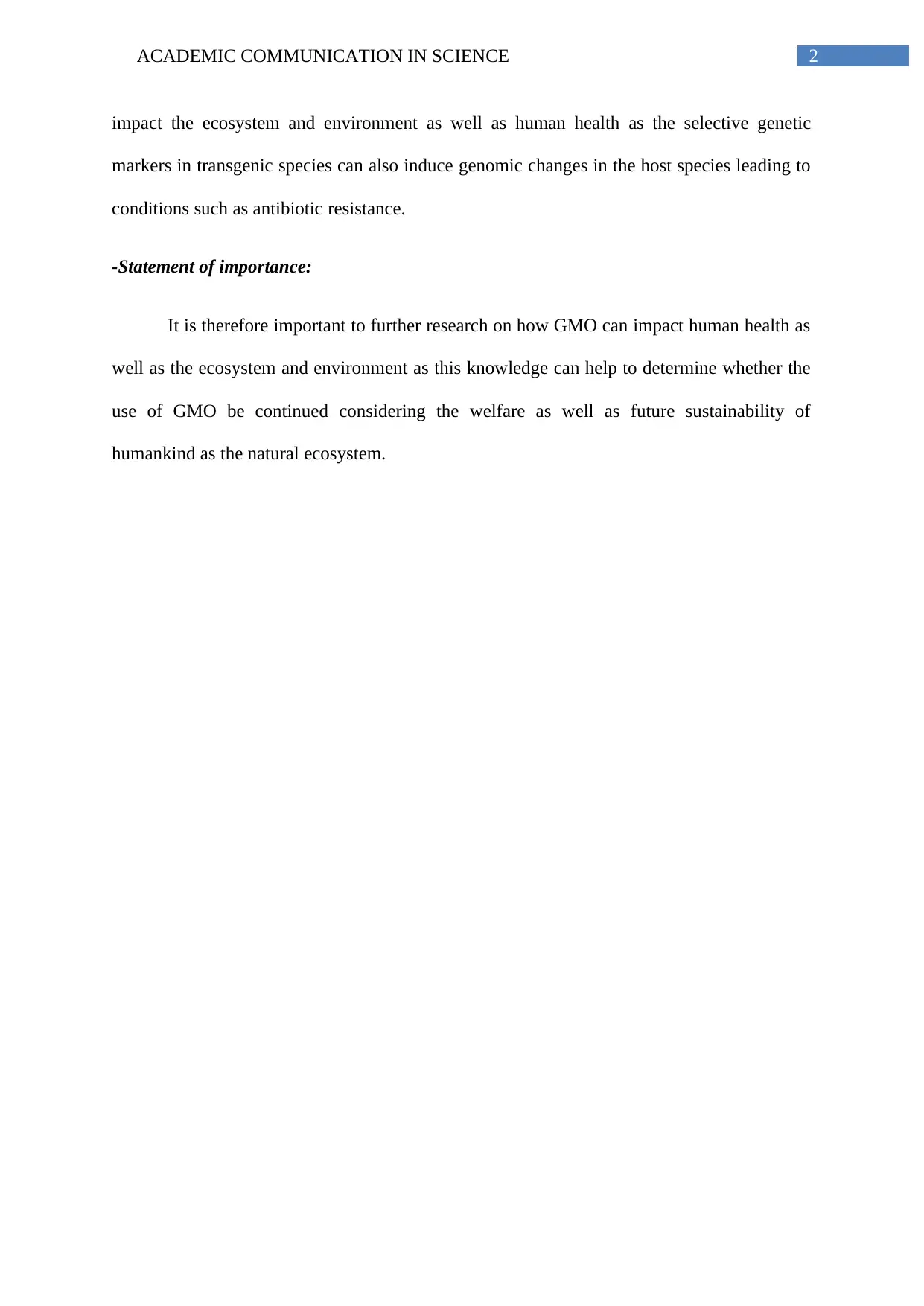
2ACADEMIC COMMUNICATION IN SCIENCE
impact the ecosystem and environment as well as human health as the selective genetic
markers in transgenic species can also induce genomic changes in the host species leading to
conditions such as antibiotic resistance.
-Statement of importance:
It is therefore important to further research on how GMO can impact human health as
well as the ecosystem and environment as this knowledge can help to determine whether the
use of GMO be continued considering the welfare as well as future sustainability of
humankind as the natural ecosystem.
impact the ecosystem and environment as well as human health as the selective genetic
markers in transgenic species can also induce genomic changes in the host species leading to
conditions such as antibiotic resistance.
-Statement of importance:
It is therefore important to further research on how GMO can impact human health as
well as the ecosystem and environment as this knowledge can help to determine whether the
use of GMO be continued considering the welfare as well as future sustainability of
humankind as the natural ecosystem.
⊘ This is a preview!⊘
Do you want full access?
Subscribe today to unlock all pages.

Trusted by 1+ million students worldwide
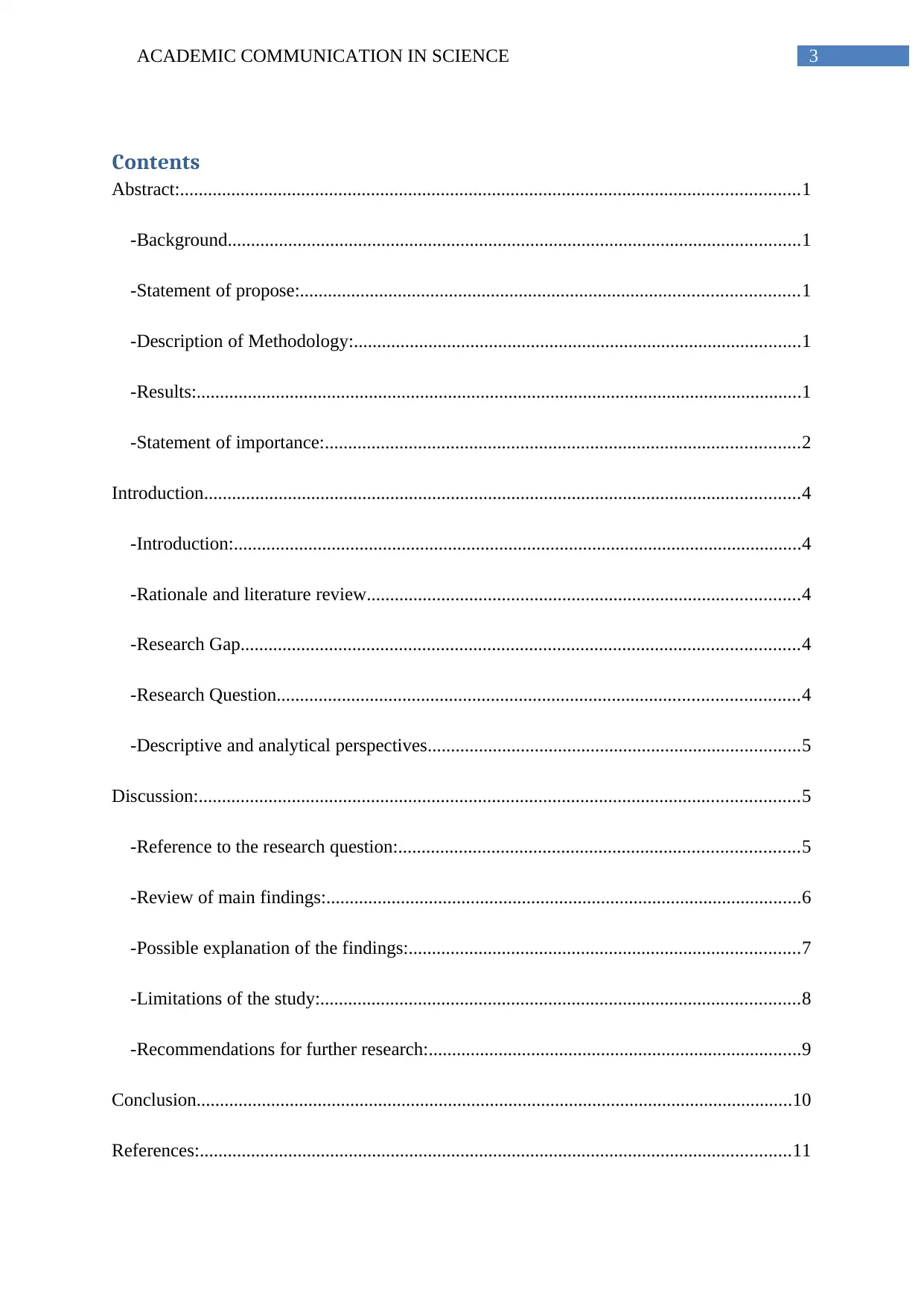
3ACADEMIC COMMUNICATION IN SCIENCE
Contents
Abstract:.....................................................................................................................................1
-Background...........................................................................................................................1
-Statement of propose:...........................................................................................................1
-Description of Methodology:................................................................................................1
-Results:..................................................................................................................................1
-Statement of importance:......................................................................................................2
Introduction................................................................................................................................4
-Introduction:..........................................................................................................................4
-Rationale and literature review.............................................................................................4
-Research Gap........................................................................................................................4
-Research Question................................................................................................................4
-Descriptive and analytical perspectives................................................................................5
Discussion:.................................................................................................................................5
-Reference to the research question:......................................................................................5
-Review of main findings:......................................................................................................6
-Possible explanation of the findings:....................................................................................7
-Limitations of the study:.......................................................................................................8
-Recommendations for further research:................................................................................9
Conclusion................................................................................................................................10
References:...............................................................................................................................11
Contents
Abstract:.....................................................................................................................................1
-Background...........................................................................................................................1
-Statement of propose:...........................................................................................................1
-Description of Methodology:................................................................................................1
-Results:..................................................................................................................................1
-Statement of importance:......................................................................................................2
Introduction................................................................................................................................4
-Introduction:..........................................................................................................................4
-Rationale and literature review.............................................................................................4
-Research Gap........................................................................................................................4
-Research Question................................................................................................................4
-Descriptive and analytical perspectives................................................................................5
Discussion:.................................................................................................................................5
-Reference to the research question:......................................................................................5
-Review of main findings:......................................................................................................6
-Possible explanation of the findings:....................................................................................7
-Limitations of the study:.......................................................................................................8
-Recommendations for further research:................................................................................9
Conclusion................................................................................................................................10
References:...............................................................................................................................11
Paraphrase This Document
Need a fresh take? Get an instant paraphrase of this document with our AI Paraphraser
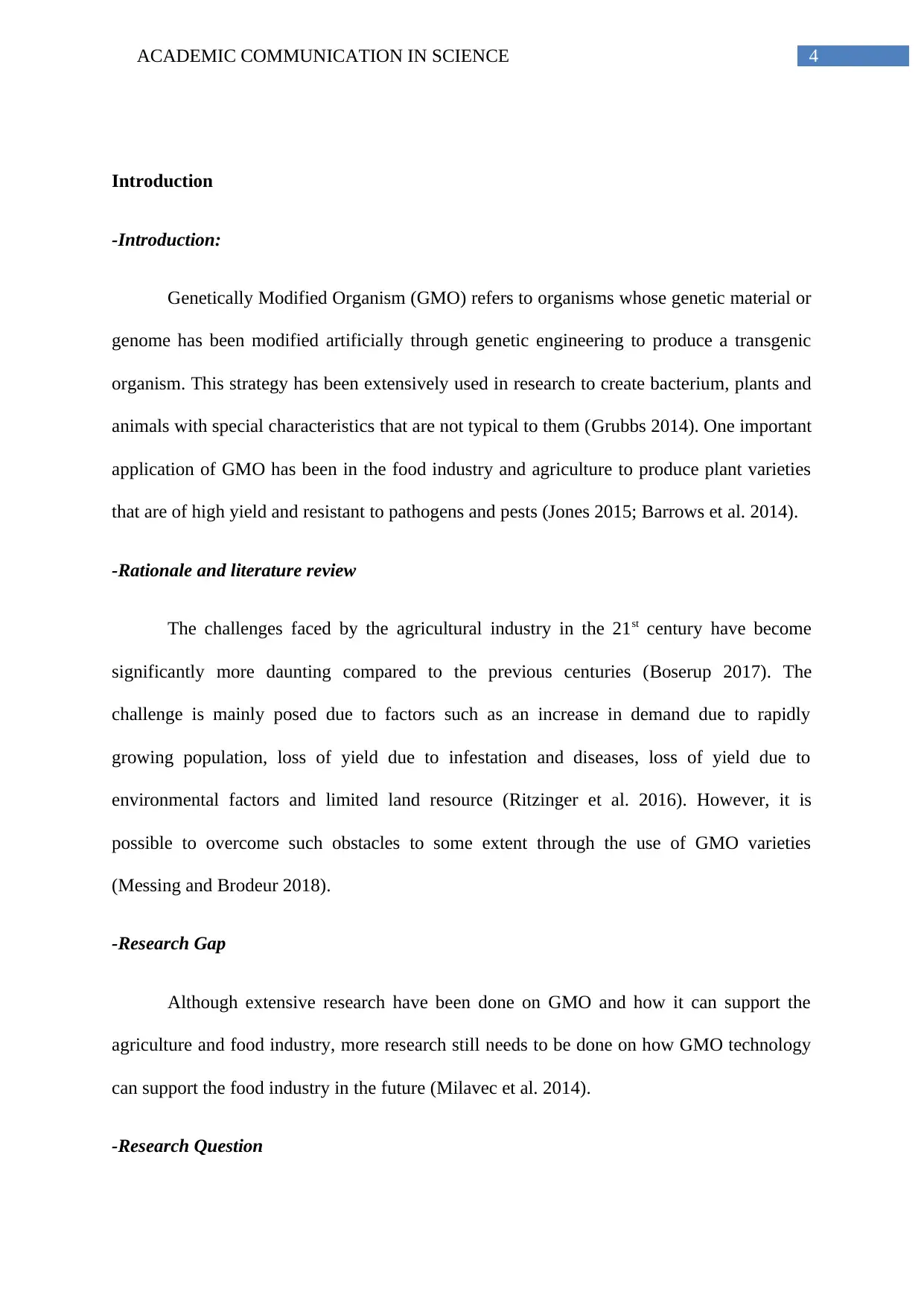
4ACADEMIC COMMUNICATION IN SCIENCE
Introduction
-Introduction:
Genetically Modified Organism (GMO) refers to organisms whose genetic material or
genome has been modified artificially through genetic engineering to produce a transgenic
organism. This strategy has been extensively used in research to create bacterium, plants and
animals with special characteristics that are not typical to them (Grubbs 2014). One important
application of GMO has been in the food industry and agriculture to produce plant varieties
that are of high yield and resistant to pathogens and pests (Jones 2015; Barrows et al. 2014).
-Rationale and literature review
The challenges faced by the agricultural industry in the 21st century have become
significantly more daunting compared to the previous centuries (Boserup 2017). The
challenge is mainly posed due to factors such as an increase in demand due to rapidly
growing population, loss of yield due to infestation and diseases, loss of yield due to
environmental factors and limited land resource (Ritzinger et al. 2016). However, it is
possible to overcome such obstacles to some extent through the use of GMO varieties
(Messing and Brodeur 2018).
-Research Gap
Although extensive research have been done on GMO and how it can support the
agriculture and food industry, more research still needs to be done on how GMO technology
can support the food industry in the future (Milavec et al. 2014).
-Research Question
Introduction
-Introduction:
Genetically Modified Organism (GMO) refers to organisms whose genetic material or
genome has been modified artificially through genetic engineering to produce a transgenic
organism. This strategy has been extensively used in research to create bacterium, plants and
animals with special characteristics that are not typical to them (Grubbs 2014). One important
application of GMO has been in the food industry and agriculture to produce plant varieties
that are of high yield and resistant to pathogens and pests (Jones 2015; Barrows et al. 2014).
-Rationale and literature review
The challenges faced by the agricultural industry in the 21st century have become
significantly more daunting compared to the previous centuries (Boserup 2017). The
challenge is mainly posed due to factors such as an increase in demand due to rapidly
growing population, loss of yield due to infestation and diseases, loss of yield due to
environmental factors and limited land resource (Ritzinger et al. 2016). However, it is
possible to overcome such obstacles to some extent through the use of GMO varieties
(Messing and Brodeur 2018).
-Research Gap
Although extensive research have been done on GMO and how it can support the
agriculture and food industry, more research still needs to be done on how GMO technology
can support the food industry in the future (Milavec et al. 2014).
-Research Question
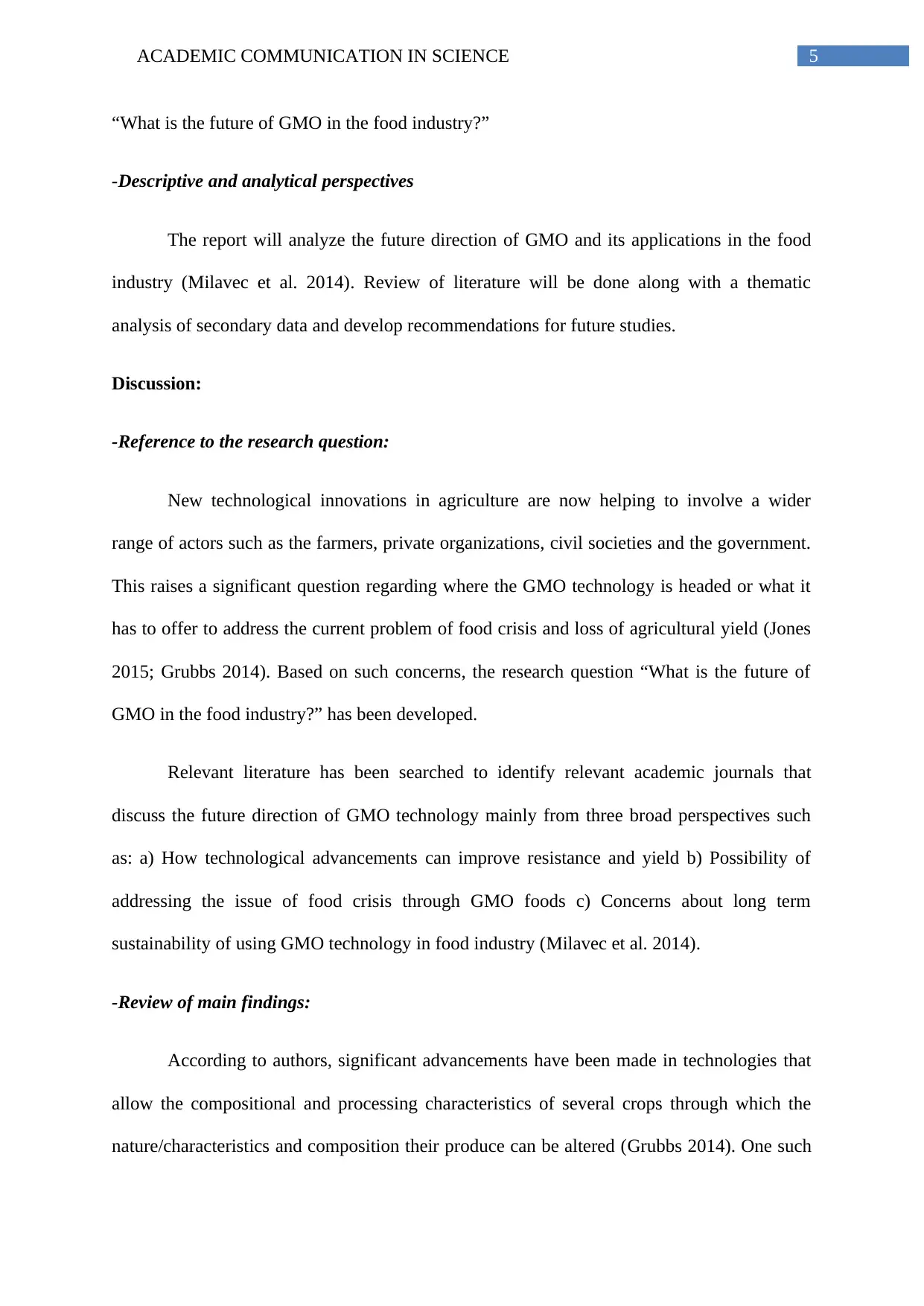
5ACADEMIC COMMUNICATION IN SCIENCE
“What is the future of GMO in the food industry?”
-Descriptive and analytical perspectives
The report will analyze the future direction of GMO and its applications in the food
industry (Milavec et al. 2014). Review of literature will be done along with a thematic
analysis of secondary data and develop recommendations for future studies.
Discussion:
-Reference to the research question:
New technological innovations in agriculture are now helping to involve a wider
range of actors such as the farmers, private organizations, civil societies and the government.
This raises a significant question regarding where the GMO technology is headed or what it
has to offer to address the current problem of food crisis and loss of agricultural yield (Jones
2015; Grubbs 2014). Based on such concerns, the research question “What is the future of
GMO in the food industry?” has been developed.
Relevant literature has been searched to identify relevant academic journals that
discuss the future direction of GMO technology mainly from three broad perspectives such
as: a) How technological advancements can improve resistance and yield b) Possibility of
addressing the issue of food crisis through GMO foods c) Concerns about long term
sustainability of using GMO technology in food industry (Milavec et al. 2014).
-Review of main findings:
According to authors, significant advancements have been made in technologies that
allow the compositional and processing characteristics of several crops through which the
nature/characteristics and composition their produce can be altered (Grubbs 2014). One such
“What is the future of GMO in the food industry?”
-Descriptive and analytical perspectives
The report will analyze the future direction of GMO and its applications in the food
industry (Milavec et al. 2014). Review of literature will be done along with a thematic
analysis of secondary data and develop recommendations for future studies.
Discussion:
-Reference to the research question:
New technological innovations in agriculture are now helping to involve a wider
range of actors such as the farmers, private organizations, civil societies and the government.
This raises a significant question regarding where the GMO technology is headed or what it
has to offer to address the current problem of food crisis and loss of agricultural yield (Jones
2015; Grubbs 2014). Based on such concerns, the research question “What is the future of
GMO in the food industry?” has been developed.
Relevant literature has been searched to identify relevant academic journals that
discuss the future direction of GMO technology mainly from three broad perspectives such
as: a) How technological advancements can improve resistance and yield b) Possibility of
addressing the issue of food crisis through GMO foods c) Concerns about long term
sustainability of using GMO technology in food industry (Milavec et al. 2014).
-Review of main findings:
According to authors, significant advancements have been made in technologies that
allow the compositional and processing characteristics of several crops through which the
nature/characteristics and composition their produce can be altered (Grubbs 2014). One such
⊘ This is a preview!⊘
Do you want full access?
Subscribe today to unlock all pages.

Trusted by 1+ million students worldwide
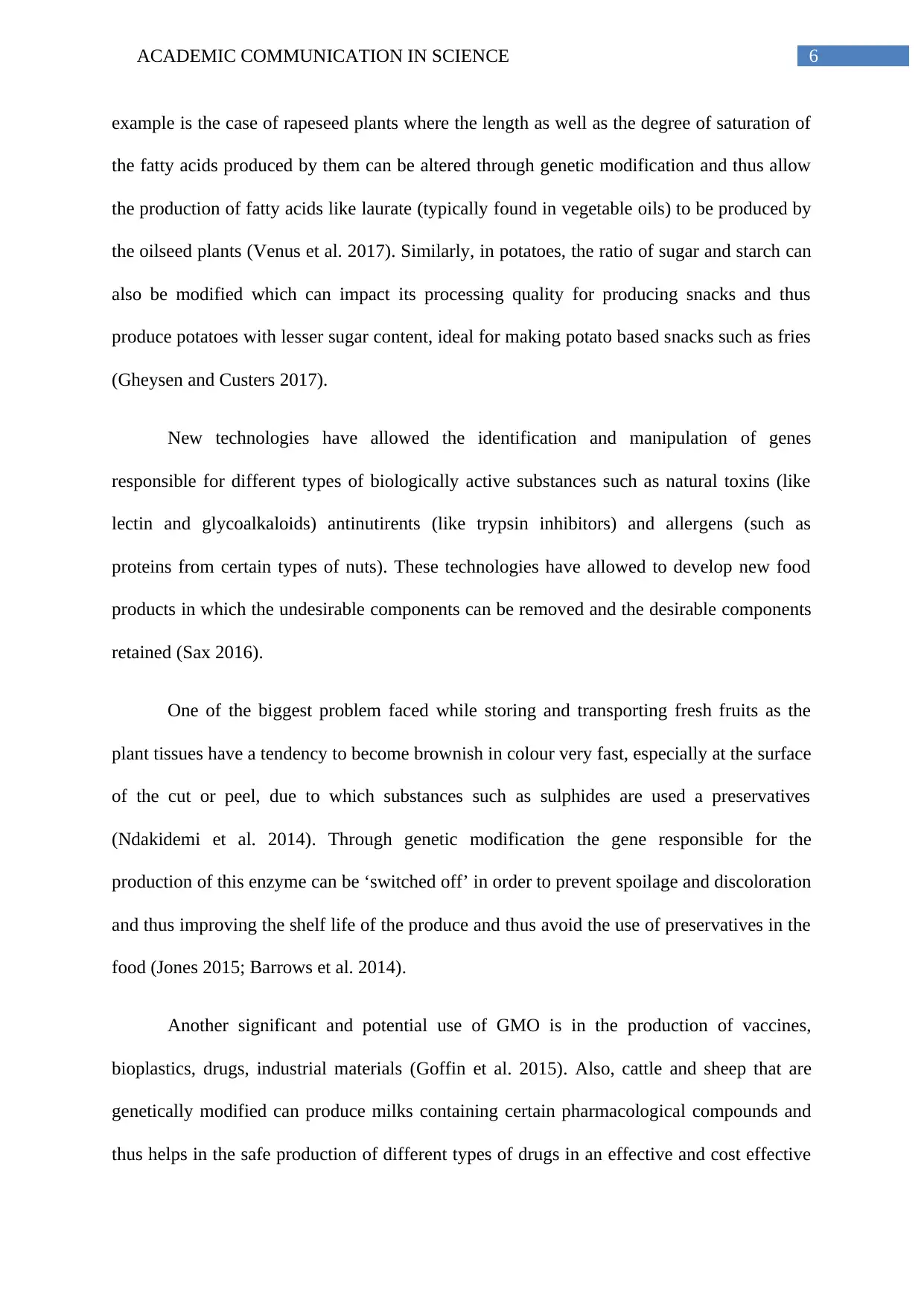
6ACADEMIC COMMUNICATION IN SCIENCE
example is the case of rapeseed plants where the length as well as the degree of saturation of
the fatty acids produced by them can be altered through genetic modification and thus allow
the production of fatty acids like laurate (typically found in vegetable oils) to be produced by
the oilseed plants (Venus et al. 2017). Similarly, in potatoes, the ratio of sugar and starch can
also be modified which can impact its processing quality for producing snacks and thus
produce potatoes with lesser sugar content, ideal for making potato based snacks such as fries
(Gheysen and Custers 2017).
New technologies have allowed the identification and manipulation of genes
responsible for different types of biologically active substances such as natural toxins (like
lectin and glycoalkaloids) antinutirents (like trypsin inhibitors) and allergens (such as
proteins from certain types of nuts). These technologies have allowed to develop new food
products in which the undesirable components can be removed and the desirable components
retained (Sax 2016).
One of the biggest problem faced while storing and transporting fresh fruits as the
plant tissues have a tendency to become brownish in colour very fast, especially at the surface
of the cut or peel, due to which substances such as sulphides are used a preservatives
(Ndakidemi et al. 2014). Through genetic modification the gene responsible for the
production of this enzyme can be ‘switched off’ in order to prevent spoilage and discoloration
and thus improving the shelf life of the produce and thus avoid the use of preservatives in the
food (Jones 2015; Barrows et al. 2014).
Another significant and potential use of GMO is in the production of vaccines,
bioplastics, drugs, industrial materials (Goffin et al. 2015). Also, cattle and sheep that are
genetically modified can produce milks containing certain pharmacological compounds and
thus helps in the safe production of different types of drugs in an effective and cost effective
example is the case of rapeseed plants where the length as well as the degree of saturation of
the fatty acids produced by them can be altered through genetic modification and thus allow
the production of fatty acids like laurate (typically found in vegetable oils) to be produced by
the oilseed plants (Venus et al. 2017). Similarly, in potatoes, the ratio of sugar and starch can
also be modified which can impact its processing quality for producing snacks and thus
produce potatoes with lesser sugar content, ideal for making potato based snacks such as fries
(Gheysen and Custers 2017).
New technologies have allowed the identification and manipulation of genes
responsible for different types of biologically active substances such as natural toxins (like
lectin and glycoalkaloids) antinutirents (like trypsin inhibitors) and allergens (such as
proteins from certain types of nuts). These technologies have allowed to develop new food
products in which the undesirable components can be removed and the desirable components
retained (Sax 2016).
One of the biggest problem faced while storing and transporting fresh fruits as the
plant tissues have a tendency to become brownish in colour very fast, especially at the surface
of the cut or peel, due to which substances such as sulphides are used a preservatives
(Ndakidemi et al. 2014). Through genetic modification the gene responsible for the
production of this enzyme can be ‘switched off’ in order to prevent spoilage and discoloration
and thus improving the shelf life of the produce and thus avoid the use of preservatives in the
food (Jones 2015; Barrows et al. 2014).
Another significant and potential use of GMO is in the production of vaccines,
bioplastics, drugs, industrial materials (Goffin et al. 2015). Also, cattle and sheep that are
genetically modified can produce milks containing certain pharmacological compounds and
thus helps in the safe production of different types of drugs in an effective and cost effective
Paraphrase This Document
Need a fresh take? Get an instant paraphrase of this document with our AI Paraphraser
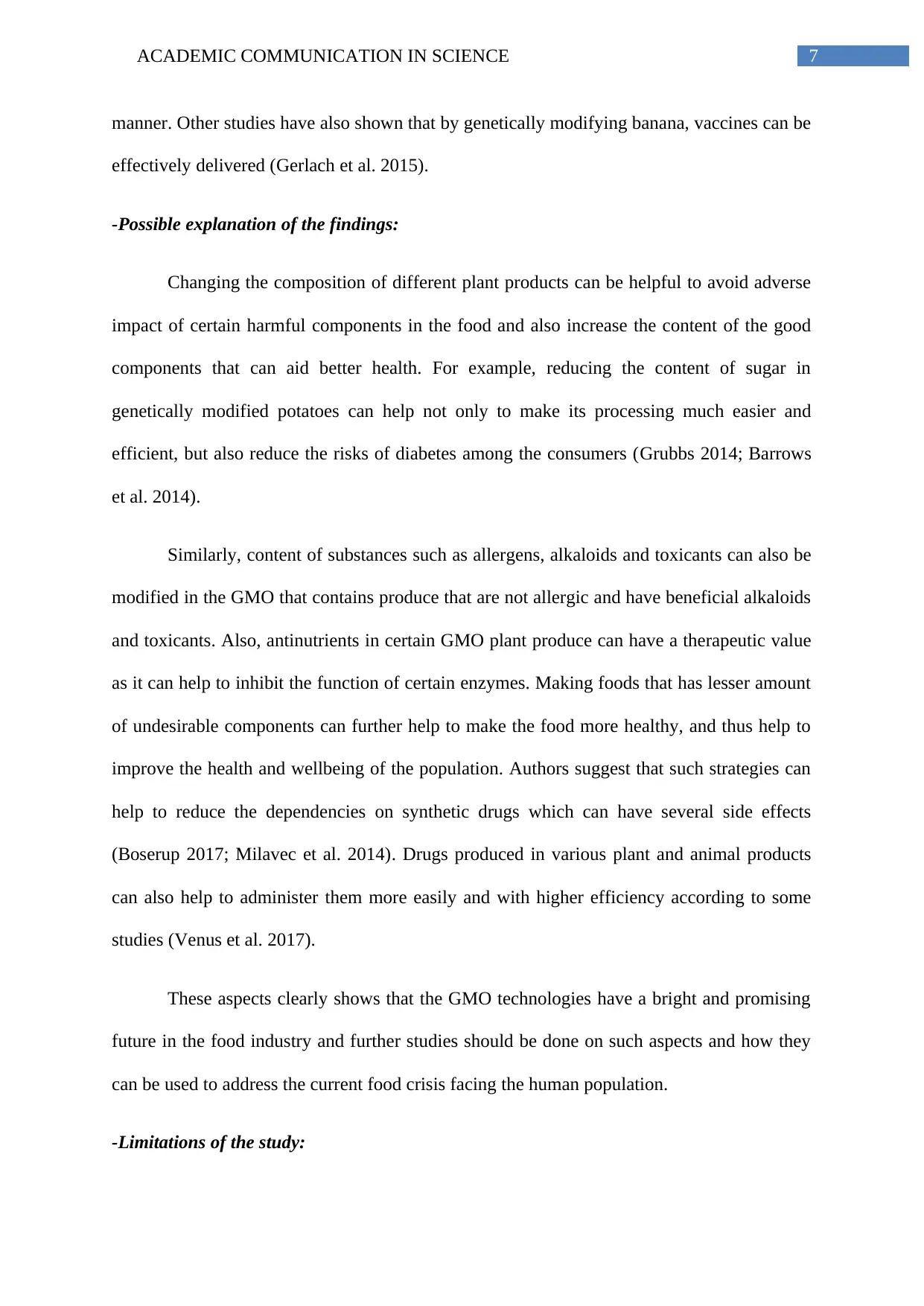
7ACADEMIC COMMUNICATION IN SCIENCE
manner. Other studies have also shown that by genetically modifying banana, vaccines can be
effectively delivered (Gerlach et al. 2015).
-Possible explanation of the findings:
Changing the composition of different plant products can be helpful to avoid adverse
impact of certain harmful components in the food and also increase the content of the good
components that can aid better health. For example, reducing the content of sugar in
genetically modified potatoes can help not only to make its processing much easier and
efficient, but also reduce the risks of diabetes among the consumers (Grubbs 2014; Barrows
et al. 2014).
Similarly, content of substances such as allergens, alkaloids and toxicants can also be
modified in the GMO that contains produce that are not allergic and have beneficial alkaloids
and toxicants. Also, antinutrients in certain GMO plant produce can have a therapeutic value
as it can help to inhibit the function of certain enzymes. Making foods that has lesser amount
of undesirable components can further help to make the food more healthy, and thus help to
improve the health and wellbeing of the population. Authors suggest that such strategies can
help to reduce the dependencies on synthetic drugs which can have several side effects
(Boserup 2017; Milavec et al. 2014). Drugs produced in various plant and animal products
can also help to administer them more easily and with higher efficiency according to some
studies (Venus et al. 2017).
These aspects clearly shows that the GMO technologies have a bright and promising
future in the food industry and further studies should be done on such aspects and how they
can be used to address the current food crisis facing the human population.
-Limitations of the study:
manner. Other studies have also shown that by genetically modifying banana, vaccines can be
effectively delivered (Gerlach et al. 2015).
-Possible explanation of the findings:
Changing the composition of different plant products can be helpful to avoid adverse
impact of certain harmful components in the food and also increase the content of the good
components that can aid better health. For example, reducing the content of sugar in
genetically modified potatoes can help not only to make its processing much easier and
efficient, but also reduce the risks of diabetes among the consumers (Grubbs 2014; Barrows
et al. 2014).
Similarly, content of substances such as allergens, alkaloids and toxicants can also be
modified in the GMO that contains produce that are not allergic and have beneficial alkaloids
and toxicants. Also, antinutrients in certain GMO plant produce can have a therapeutic value
as it can help to inhibit the function of certain enzymes. Making foods that has lesser amount
of undesirable components can further help to make the food more healthy, and thus help to
improve the health and wellbeing of the population. Authors suggest that such strategies can
help to reduce the dependencies on synthetic drugs which can have several side effects
(Boserup 2017; Milavec et al. 2014). Drugs produced in various plant and animal products
can also help to administer them more easily and with higher efficiency according to some
studies (Venus et al. 2017).
These aspects clearly shows that the GMO technologies have a bright and promising
future in the food industry and further studies should be done on such aspects and how they
can be used to address the current food crisis facing the human population.
-Limitations of the study:

8ACADEMIC COMMUNICATION IN SCIENCE
In the study, relevant literature was analyzed to find out the opportunities of using
GMO to produce healthier foods as well as food that contain active biological ingredients that
can act as medicines and help to increase the health and wellbeing of the consumers (Milavec
et al. 2014). The study however has some limitations such as:
Time- Due to a restricted amount of time in which the research had to be conducted, a
detailed analysis of all the relevant literature was not feasible due to which a brief review of
academic journals in the last 5 years was done.
Impact on human health- Another important limitation of GMO studies is the lack of strong
evidence on how GMO can impact the health of humans and also that of the ecosystem. This
is an important consideration since it can affect the long term usage of GMO to address the
food crisis problem.
Secondary Research- The findings have included the secondary research data on which
thematic review was done. Since no primary data have been used, it was also another
limitation of the study as it depended on the interpretations of other authors.
-Recommendations for further research:
In order to progress further in the study of GMO and its viability for the future
population needs, certain important aspects also needs to be comprehensively studied and
analyzed such as:
Impact of GMO on human health- It is important to understand how GMO can be interfering
with the normal biological processes in a cell and how it can affect the health and wellbeing
of the consumers. According to some authors, usage of antibiotic resistant genes in certain
plants can induce antibiotic resistance among the human gut flora, which then can then
promote antibiotic resistance to clinically useful antibiotics. This can in turn increase the risks
In the study, relevant literature was analyzed to find out the opportunities of using
GMO to produce healthier foods as well as food that contain active biological ingredients that
can act as medicines and help to increase the health and wellbeing of the consumers (Milavec
et al. 2014). The study however has some limitations such as:
Time- Due to a restricted amount of time in which the research had to be conducted, a
detailed analysis of all the relevant literature was not feasible due to which a brief review of
academic journals in the last 5 years was done.
Impact on human health- Another important limitation of GMO studies is the lack of strong
evidence on how GMO can impact the health of humans and also that of the ecosystem. This
is an important consideration since it can affect the long term usage of GMO to address the
food crisis problem.
Secondary Research- The findings have included the secondary research data on which
thematic review was done. Since no primary data have been used, it was also another
limitation of the study as it depended on the interpretations of other authors.
-Recommendations for further research:
In order to progress further in the study of GMO and its viability for the future
population needs, certain important aspects also needs to be comprehensively studied and
analyzed such as:
Impact of GMO on human health- It is important to understand how GMO can be interfering
with the normal biological processes in a cell and how it can affect the health and wellbeing
of the consumers. According to some authors, usage of antibiotic resistant genes in certain
plants can induce antibiotic resistance among the human gut flora, which then can then
promote antibiotic resistance to clinically useful antibiotics. This can in turn increase the risks
⊘ This is a preview!⊘
Do you want full access?
Subscribe today to unlock all pages.

Trusted by 1+ million students worldwide
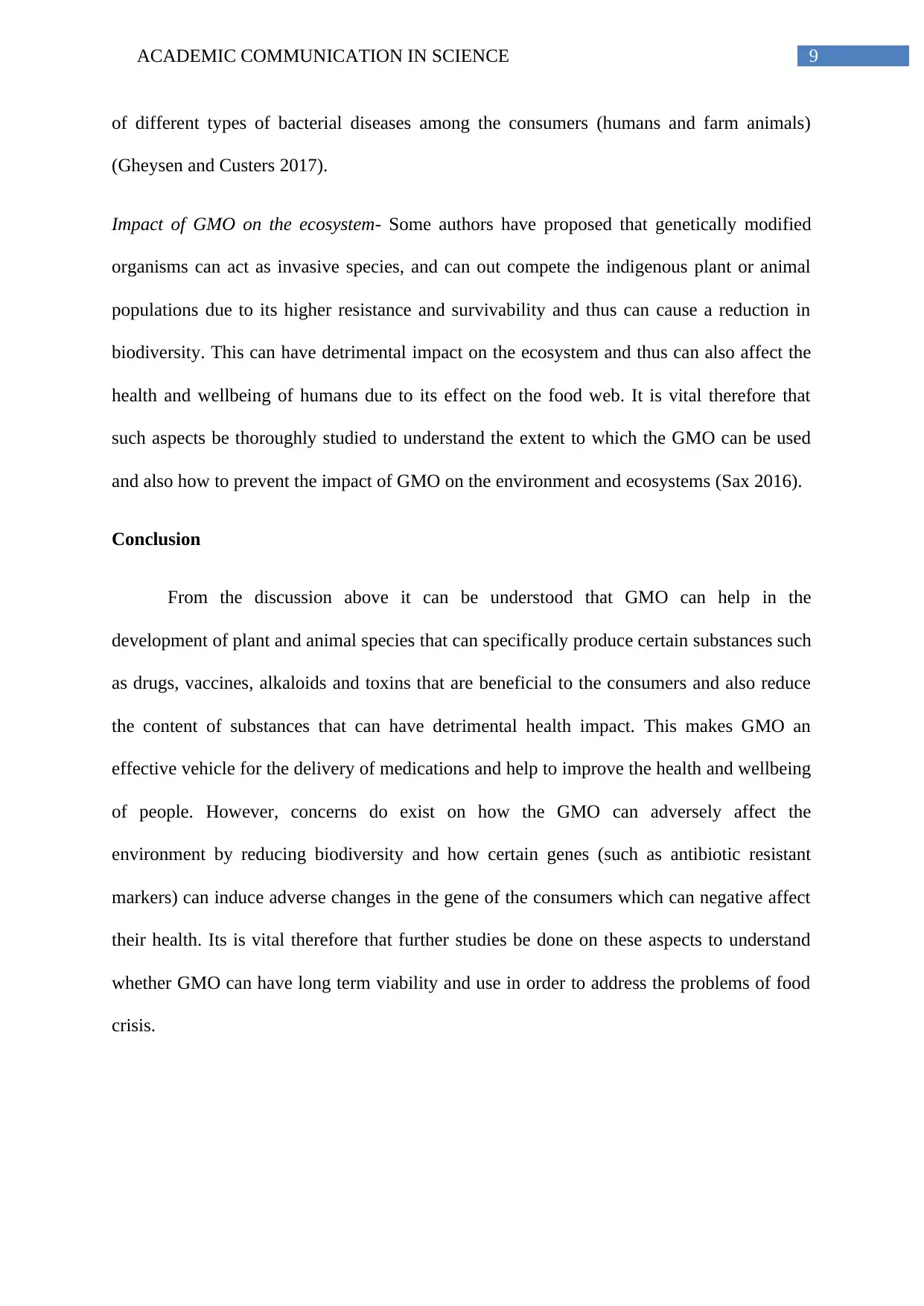
9ACADEMIC COMMUNICATION IN SCIENCE
of different types of bacterial diseases among the consumers (humans and farm animals)
(Gheysen and Custers 2017).
Impact of GMO on the ecosystem- Some authors have proposed that genetically modified
organisms can act as invasive species, and can out compete the indigenous plant or animal
populations due to its higher resistance and survivability and thus can cause a reduction in
biodiversity. This can have detrimental impact on the ecosystem and thus can also affect the
health and wellbeing of humans due to its effect on the food web. It is vital therefore that
such aspects be thoroughly studied to understand the extent to which the GMO can be used
and also how to prevent the impact of GMO on the environment and ecosystems (Sax 2016).
Conclusion
From the discussion above it can be understood that GMO can help in the
development of plant and animal species that can specifically produce certain substances such
as drugs, vaccines, alkaloids and toxins that are beneficial to the consumers and also reduce
the content of substances that can have detrimental health impact. This makes GMO an
effective vehicle for the delivery of medications and help to improve the health and wellbeing
of people. However, concerns do exist on how the GMO can adversely affect the
environment by reducing biodiversity and how certain genes (such as antibiotic resistant
markers) can induce adverse changes in the gene of the consumers which can negative affect
their health. Its is vital therefore that further studies be done on these aspects to understand
whether GMO can have long term viability and use in order to address the problems of food
crisis.
of different types of bacterial diseases among the consumers (humans and farm animals)
(Gheysen and Custers 2017).
Impact of GMO on the ecosystem- Some authors have proposed that genetically modified
organisms can act as invasive species, and can out compete the indigenous plant or animal
populations due to its higher resistance and survivability and thus can cause a reduction in
biodiversity. This can have detrimental impact on the ecosystem and thus can also affect the
health and wellbeing of humans due to its effect on the food web. It is vital therefore that
such aspects be thoroughly studied to understand the extent to which the GMO can be used
and also how to prevent the impact of GMO on the environment and ecosystems (Sax 2016).
Conclusion
From the discussion above it can be understood that GMO can help in the
development of plant and animal species that can specifically produce certain substances such
as drugs, vaccines, alkaloids and toxins that are beneficial to the consumers and also reduce
the content of substances that can have detrimental health impact. This makes GMO an
effective vehicle for the delivery of medications and help to improve the health and wellbeing
of people. However, concerns do exist on how the GMO can adversely affect the
environment by reducing biodiversity and how certain genes (such as antibiotic resistant
markers) can induce adverse changes in the gene of the consumers which can negative affect
their health. Its is vital therefore that further studies be done on these aspects to understand
whether GMO can have long term viability and use in order to address the problems of food
crisis.
Paraphrase This Document
Need a fresh take? Get an instant paraphrase of this document with our AI Paraphraser
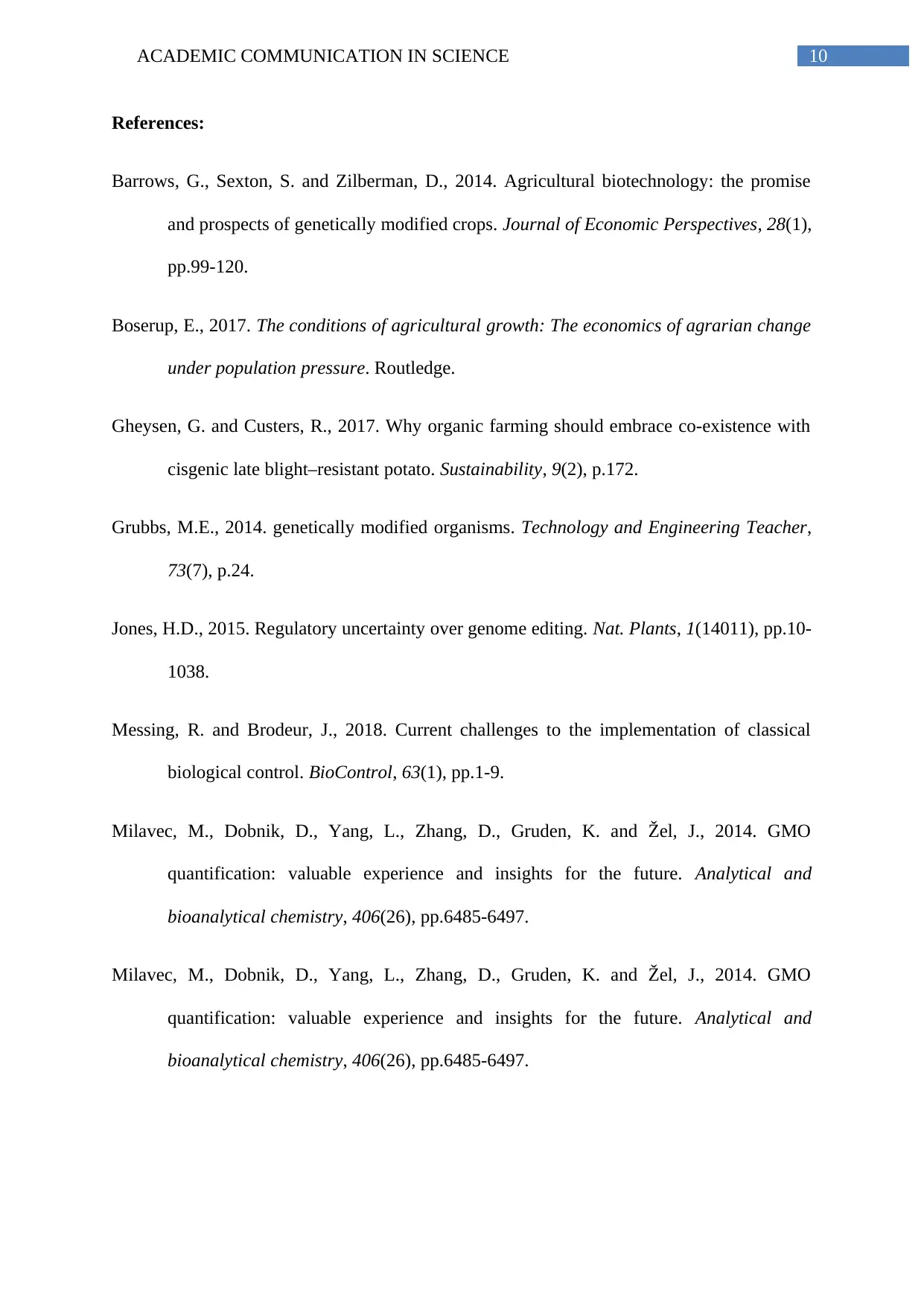
10ACADEMIC COMMUNICATION IN SCIENCE
References:
Barrows, G., Sexton, S. and Zilberman, D., 2014. Agricultural biotechnology: the promise
and prospects of genetically modified crops. Journal of Economic Perspectives, 28(1),
pp.99-120.
Boserup, E., 2017. The conditions of agricultural growth: The economics of agrarian change
under population pressure. Routledge.
Gheysen, G. and Custers, R., 2017. Why organic farming should embrace co-existence with
cisgenic late blight–resistant potato. Sustainability, 9(2), p.172.
Grubbs, M.E., 2014. genetically modified organisms. Technology and Engineering Teacher,
73(7), p.24.
Jones, H.D., 2015. Regulatory uncertainty over genome editing. Nat. Plants, 1(14011), pp.10-
1038.
Messing, R. and Brodeur, J., 2018. Current challenges to the implementation of classical
biological control. BioControl, 63(1), pp.1-9.
Milavec, M., Dobnik, D., Yang, L., Zhang, D., Gruden, K. and Žel, J., 2014. GMO
quantification: valuable experience and insights for the future. Analytical and
bioanalytical chemistry, 406(26), pp.6485-6497.
Milavec, M., Dobnik, D., Yang, L., Zhang, D., Gruden, K. and Žel, J., 2014. GMO
quantification: valuable experience and insights for the future. Analytical and
bioanalytical chemistry, 406(26), pp.6485-6497.
References:
Barrows, G., Sexton, S. and Zilberman, D., 2014. Agricultural biotechnology: the promise
and prospects of genetically modified crops. Journal of Economic Perspectives, 28(1),
pp.99-120.
Boserup, E., 2017. The conditions of agricultural growth: The economics of agrarian change
under population pressure. Routledge.
Gheysen, G. and Custers, R., 2017. Why organic farming should embrace co-existence with
cisgenic late blight–resistant potato. Sustainability, 9(2), p.172.
Grubbs, M.E., 2014. genetically modified organisms. Technology and Engineering Teacher,
73(7), p.24.
Jones, H.D., 2015. Regulatory uncertainty over genome editing. Nat. Plants, 1(14011), pp.10-
1038.
Messing, R. and Brodeur, J., 2018. Current challenges to the implementation of classical
biological control. BioControl, 63(1), pp.1-9.
Milavec, M., Dobnik, D., Yang, L., Zhang, D., Gruden, K. and Žel, J., 2014. GMO
quantification: valuable experience and insights for the future. Analytical and
bioanalytical chemistry, 406(26), pp.6485-6497.
Milavec, M., Dobnik, D., Yang, L., Zhang, D., Gruden, K. and Žel, J., 2014. GMO
quantification: valuable experience and insights for the future. Analytical and
bioanalytical chemistry, 406(26), pp.6485-6497.
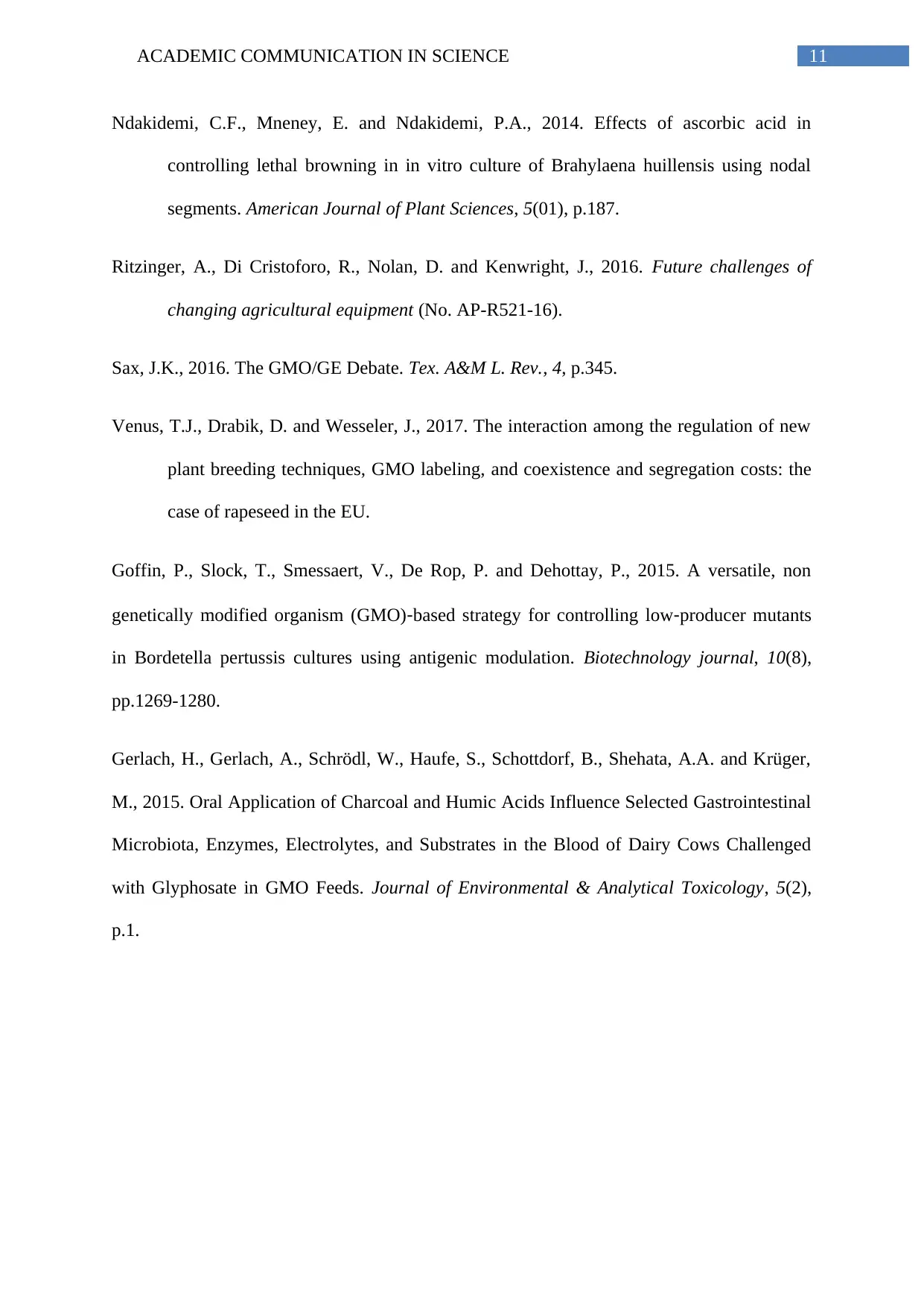
11ACADEMIC COMMUNICATION IN SCIENCE
Ndakidemi, C.F., Mneney, E. and Ndakidemi, P.A., 2014. Effects of ascorbic acid in
controlling lethal browning in in vitro culture of Brahylaena huillensis using nodal
segments. American Journal of Plant Sciences, 5(01), p.187.
Ritzinger, A., Di Cristoforo, R., Nolan, D. and Kenwright, J., 2016. Future challenges of
changing agricultural equipment (No. AP-R521-16).
Sax, J.K., 2016. The GMO/GE Debate. Tex. A&M L. Rev., 4, p.345.
Venus, T.J., Drabik, D. and Wesseler, J., 2017. The interaction among the regulation of new
plant breeding techniques, GMO labeling, and coexistence and segregation costs: the
case of rapeseed in the EU.
Goffin, P., Slock, T., Smessaert, V., De Rop, P. and Dehottay, P., 2015. A versatile, non
genetically modified organism (GMO)‐based strategy for controlling low‐producer mutants
in Bordetella pertussis cultures using antigenic modulation. Biotechnology journal, 10(8),
pp.1269-1280.
Gerlach, H., Gerlach, A., Schrödl, W., Haufe, S., Schottdorf, B., Shehata, A.A. and Krüger,
M., 2015. Oral Application of Charcoal and Humic Acids Influence Selected Gastrointestinal
Microbiota, Enzymes, Electrolytes, and Substrates in the Blood of Dairy Cows Challenged
with Glyphosate in GMO Feeds. Journal of Environmental & Analytical Toxicology, 5(2),
p.1.
Ndakidemi, C.F., Mneney, E. and Ndakidemi, P.A., 2014. Effects of ascorbic acid in
controlling lethal browning in in vitro culture of Brahylaena huillensis using nodal
segments. American Journal of Plant Sciences, 5(01), p.187.
Ritzinger, A., Di Cristoforo, R., Nolan, D. and Kenwright, J., 2016. Future challenges of
changing agricultural equipment (No. AP-R521-16).
Sax, J.K., 2016. The GMO/GE Debate. Tex. A&M L. Rev., 4, p.345.
Venus, T.J., Drabik, D. and Wesseler, J., 2017. The interaction among the regulation of new
plant breeding techniques, GMO labeling, and coexistence and segregation costs: the
case of rapeseed in the EU.
Goffin, P., Slock, T., Smessaert, V., De Rop, P. and Dehottay, P., 2015. A versatile, non
genetically modified organism (GMO)‐based strategy for controlling low‐producer mutants
in Bordetella pertussis cultures using antigenic modulation. Biotechnology journal, 10(8),
pp.1269-1280.
Gerlach, H., Gerlach, A., Schrödl, W., Haufe, S., Schottdorf, B., Shehata, A.A. and Krüger,
M., 2015. Oral Application of Charcoal and Humic Acids Influence Selected Gastrointestinal
Microbiota, Enzymes, Electrolytes, and Substrates in the Blood of Dairy Cows Challenged
with Glyphosate in GMO Feeds. Journal of Environmental & Analytical Toxicology, 5(2),
p.1.
⊘ This is a preview!⊘
Do you want full access?
Subscribe today to unlock all pages.

Trusted by 1+ million students worldwide
1 out of 12
Related Documents
Your All-in-One AI-Powered Toolkit for Academic Success.
+13062052269
info@desklib.com
Available 24*7 on WhatsApp / Email
![[object Object]](/_next/static/media/star-bottom.7253800d.svg)
Unlock your academic potential
Copyright © 2020–2025 A2Z Services. All Rights Reserved. Developed and managed by ZUCOL.





